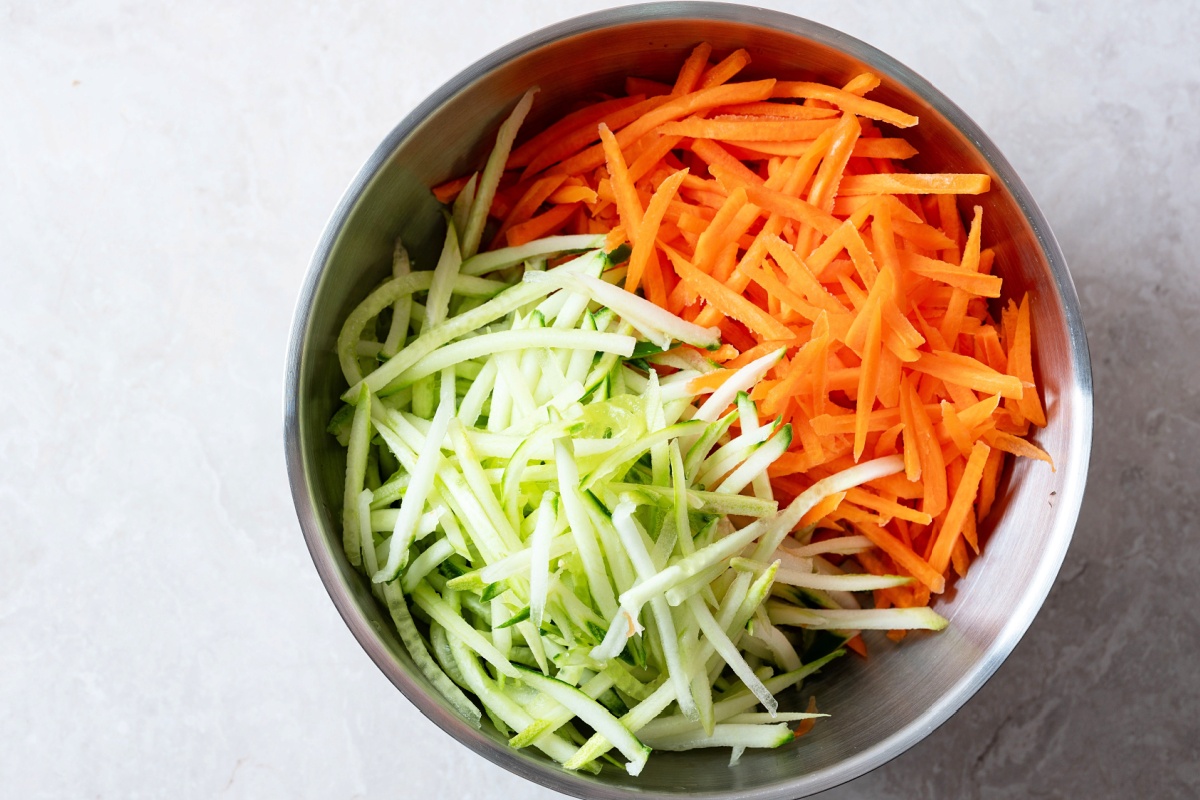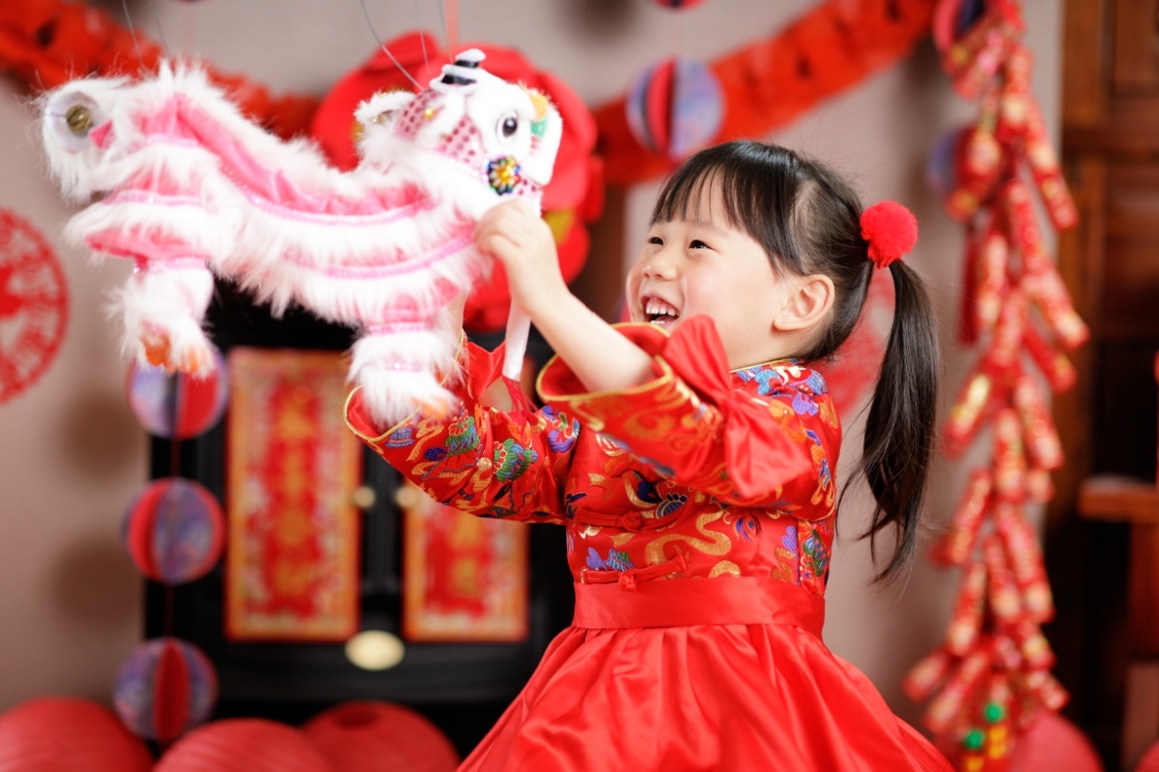Sweet Chili Carrot Cucumber Salad

Sweet Chili Carrot Cucumber Salad
Fresh, crunchy, and zesty, this cucumber and carrot salad is the perfect sidekick to any meal!
Crisp veggies meet a tangy, lightly spiced, honey-sweetened dressing in a refreshing mix of textures and tastes. For the best flavor, let the salad rest for 10 minutes to allow the veggies to soak up every drop of the flavor-packed dressing!
Happy & Healthy Cooking,
Fun-Da-Mentals Kitchen Skills
- marinate :
to soak food in a seasoned liquid to add flavor and tenderize it before cooking.
- measure :
to calculate the specific amount of an ingredient required using a measuring tool (like measuring cups or spoons).
- stir :
to mix together two or more ingredients with a spoon or spatula, usually in a circle pattern, or figure eight, or in whatever direction you like!
Equipment Checklist
- Large mixing bowl
- Cutting board
- Kid-safe knife
- Grater
- Small mixing bowl
- Measuring spoons
- Wooden spoon
Ingredients
Sweet Chili Carrot Cucumber Salad
- 2 green onions
- 2 cucumbers
- 1 large carrot
- 1 tsp salt
- 1 tsp vegetable oil **
- 1 T honey
- 1/2 tsp garlic powder
- 1 tsp crushed red pepper flakes **(Omit for NIGHTSHADE ALLERGY)**
- 1 T rice vinegar
Food Allergen Substitutions
Sweet Chili Carrot Cucumber Salad
- Soy: Substitute canola oil or other nut-free oil for vegetable oil.
- Nightshade: Omit crushed red pepper flakes.
Instructions
Sweet Chili Carrot Cucumber Salad
chop + measure + stir
Chop 2 green onions and grate 2 cucumbers and 1 carrot into a mixing bowl. Sprinkle them with 1 teaspoon of salt and reserve for later. In a smaller bowl, measure and mix 1 teaspoon vegetable oil, 1 tablespoon honey, 1/2 teaspoon garlic powder, 1 teaspoon crushed red pepper flakes, and 1 tablespoon rice vinegar and whisk them together.
marinate + serve
Squeeze the cucumber mixture a couple of times, then drain all the water from the bowl. The salt draws the water out of the cucumbers and carrots to keep the salad from being too wet. Pour the mixture of oil, vinegar, and spices over the cucumber and carrot salad. Mix and allow the cucumbers to sit for at least 10 minutes to soak up all that delicious dressing. This is called marination, or when foods sit in flavorful, acidic liquids to soften them and add flavor. This salad pairs well with Asian food, like our Tasty Tofu Indonesian "Satay" Sticks.

Hi! I’m Cucumber!
"I'm as cool as a cucumber. Actually, I am a cucumber! I have a thick, dark green peel; I am longer than I am wide; and I am a fruit that's often used as a veggie! There are three types of cucumbers: slicing, pickling, and burpless. The slicing and burpless varieties, with or without their peels, are tasty and refreshing sliced, chopped, or minced in salads, sandwiches, salsa, sauces, appetizers, and smoothies or other drinks. The pickling cucumber eventually becomes a pickle (after its pickling spa treatment)!"
History & Etymology
- Cucumbers are one of the oldest known cultivated vegetables. They have been grown for at least 3,000 years and are believed to have originated in India.
- The early Greeks or Romans may have introduced cucumbers to Europe. Records indicate that the French cultivated them in the 9th century and the English in the 14th century. Then Spanish explorers brought cucumbers to the Americas in the 16th century.
- Pickled cucumbers, or pickles, may have been produced first by workers building the Great Wall of China or by people in Mesopotamia's Tigris Valley.
- A 1630 book called "New England's Plantation" by Francis Higginson, describing plants grown in a garden on Conant's Island in Boston Harbor, mentions "cowcumbers." The cucumber may have been dubbed cowcumber due to thinking at that time that uncooked vegetables were fit only for cows.
- The word "cucumber" comes from late Middle English, from the Old French "cocombre," from the Latin "cucumis."
Anatomy
- The cucumber is a creeping vine plant that is part of the Cucurbitaceae or gourd family. Other members are melon, squash, pumpkin, and watermelon. Cucumbers grow on a vine, often in sandy soil. Sandy soil warms faster in the spring, giving cucumbers a more favorable growing environment.
- Cucumber length varies. Slicers are 6 to 8 inches, burpless 8 to 10 inches, and picklers are 3 to 5 inches long.
- Cucumbers have a mild melon flavor. Slicing cucumbers will have seeds in their flesh, preferably small, soft seeds. Burpless cucumbers are slightly sweeter with a more tender skin and are easier to digest. They may also have no or very few seeds.
- "Cool as a cucumber" isn't just a catchy phrase. A cucumber's inner temperature can be 10 to 20 degrees cooler than the outside air. This is because it consists mainly of water, which also applies to watermelons, and it takes more energy to heat the water inside the cucumber than the air around it. No wonder these are such summertime favorites! However, we don't say "as cool as a watermelon," so how did this expression become part of our vocabulary? It may have come from a poem in John Gay's Poems, New Song on New Similes from 1732.
How to Pick, Buy, & Eat
- Cucumbers are ready to be harvested 50 to 70 days after planting. They are ripe when they are firm and bright or dark green. Slicing cucumbers will be six to eight inches long. Avoid leaving them on the vine too long, or their taste may become bitter and their rind tougher.
- At the store, look for firm cucumbers without blemishes, wrinkles, or soft spots. Organic cucumbers are the best choice to avoid pesticide residue, if available. In addition, washing them reduces the amount of residue and pathogens.
- If you don't eat your fresh, uncut cucumbers immediately, store them in your refrigerator crisper drawer in a plastic bag for up to three days if unwaxed and up to a week if waxed.
- You can eat slicing and burpless cucumbers by themselves, slice or chop them into salads, or blend them into sauces and smoothies.
- Pickling cucumbers are pickled whole or sliced in brine, sugar, vinegar, and spices. There are several kinds of pickles, such as sweet, bread-and-butter, gherkin, and kosher dill.
Nutrition
- Cucumbers are 96 percent water, have very little fat, and are low in calories.
- Cucumbers contain small amounts of the vitamins you need every day and 16 percent of the daily value of vitamin K, which helps with blood clotting.
What is Cucumber Salad?

- A cucumber salad consists of sliced or chopped cucumbers with a vinegary or creamy dressing. A vinaigrette made with wine vinegar is also an option. Salting the cucumbers first by putting them in a colander, sprinkling salt on them, and letting them sit for a few minutes helps remove extra moisture and helps keep them crisp, not soggy. Smashing the cucumbers helps them to absorb and hold the dressing for better flavor.
- Persian cucumbers are the best variety for cucumber salad because of their mild flavor and thin skins you do not have to peel. You can also use English cucumbers. Generally, cucumbers do not need to be peeled, but if a cucumber has a thicker skin, you may want to peel it first.
- A refreshing summer version of a cucumber salad includes watermelon. An Asian version uses rice vinegar with added ginger, soy sauce, and sesame seeds. Korean cucumber salad ("oi muchim") is a spicy version, and the German "gurkensalat" (cucumber salad) may have a vinegar-based dressing with dill or onions or a creamy one using sour cream or yogurt.
Let's Learn About China!

- China's official name is The People's Republic of China. It became a republic in 1912; however, the first Chinese dynasty appeared around 2100 BCE. China is one of the largest countries in the world, and it has the most people!
- The official language of China is Mandarin. However, various dialects are spoken in different regions of the country. For example, in Shanghai, they speak Shanghainese.
- China is around the same size as the continental United States but only has one official time zone. The continental US has four.
- China's capital city is Beijing, while the most populated city is Shanghai.
- The Great Wall in China is the largest man-made construction on Earth, stretching an incredible 5,500 miles. Its builders used mortar that included sticky rice to bind the Great Wall's stones!
- China's land is diverse, with high mountains, low coastal lands, deserts, and damp tropical areas. Just like the United States!
- The Chinese are known for their papermaking, porcelain, and silk cloth. In addition to paper, they also invented the compass during the Han dynasty (202 BCE to 220 CE), woodblock printing in the Tang dynasty (by 7th century), gunpowder in the Tang dynasty (9th century), and movable type made of porcelain (for printing) between 1039 and 1048 CE, during the Song dynasty.
- Chinese cuisine varies by region. Climate, local agriculture, ethnic and class backgrounds, and outside influences all contribute to China's food diversity. There are eight major regional Chinese cuisines: Anhui, Cantonese, Fujian, Hunan, Jiangsu, Shandong, Szechuan, and Zhejiang.
- Wheat is farmed in northern China, so noodles and other foods made from wheat are consumed more in the North. On the other hand, rice is cultivated in southern China; therefore, rice is a staple in the South.
- Tea has long been part of Chinese culture across all parts of society. China was the first country to grow and drink tea and, today, it exports the most green tea worldwide.
What's It Like to Be a Kid in China?
- School success is greatly emphasized in China. Chinese kids go to school five days a week (six days before 1995), and their school day runs from 7:30 or 8 am until 4 or 5 pm. After school, they might do homework for three hours.
- In primary school, kids learn the Chinese language, which is made up of about 7,000 characters, not letters. The characters represent words. By the time they finish primary school, they will have learned about 4,000 characters. They will also learn a foreign language, especially English.
- Kids may not have aunts, uncles, or cousins because, at one time, the Chinese government allowed couples to have just one child due to the high population. That later changed to two, and in May 2021, the policy changed again to allow three kids, so now a child may have a sibling or two.
- Some of the holidays that kids celebrate with their families are Chinese New Year, the Dragon Boat Festival, and National Day. National Day is celebrated with fireworks and parades to commemorate the formal proclamation of the People's Republic of China on October 1, 1949.
- Kids enjoy playing ping pong, basketball, volleyball, and badminton. They also play video games and ride their bikes.
- Rice and noodles are staples, and kids may eat these at every meal. They'll eat their food using chopsticks, not forks!




